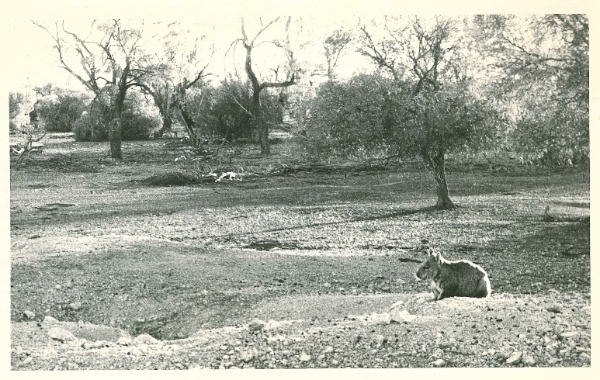In late 1967 and early 1968, members of the Natural History Society, accompanied by wombat enthusiasts Jack and Peg Conquest, made several visits to Portee Station near Blanchetown – to observe the severe impact of drought on the wombat population in the Murraylands. These visits provided the final impetus to establish the Moorunde Wildlife Reserve. Below are a selection of photographs taken by member Alwin Clements during these excursions (captions by Alwin Clements).

The drought year 1967 near Sedan.

Cleared land. The cause of the degradation of the environment. Drought and dust-storms. This is the property joining Portee Station on the western boundary, 1967.

Cleared land. A further view of clearing of the Mallee in a 250mm rainfall area, 1967.

Society Members. The day we visited Portee Station property to view the starving wombats, December 1967. All that remains is Zygophyllum which is inedible.

Dr. John Coulter applying insecticide (DDT) on captured wombat held by Jack Conquest, Portee station, December 1967.

Mark inspecting a Wedge-tailed Eagle’s nest, Portee, 1967.

Wombat on Portee Station during drought in 1967.

A wombat above ground during daylight with drought conditions, Portee.

We camped over night on Lake Short. Photograph of large Swamp Box (Eucalyptus largiflorens), 1967.

Starving wombats sun themselves to warm their bodies to try to stay alive. They are nocturnal animals. Portee, 1967.

This wombat was caught, given an injection of vitamin E (for shock) and a drink of water, an insect powder dusting and released, Portee, 1967.

Peg Conquest giving a drink to a caught wombat on Portee, May 1968.

Historic Meeting on Portee Station, May 1968. (L to R) Helge & Phyllis Hergstrom, Marjorie Molineux, Connie Wilks, Louis Power (owner of Portee Station), Milton Wilks, Berna Clements, Hubert Pitt, children, Peg Conquest, Trevor Mathews, Jack Conquest, Bert Molineux, Barry Warren, George Woolmer. Taken by Alwin Clements.
